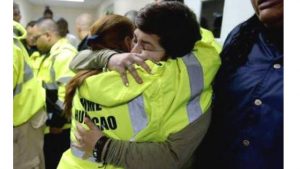
Rescue team members Candida Lozada (left) and Stephanie Rivera embrace as they wait to assist in the aftermath of Hurricane Maria in Humacao, Puerto Rico, yesterday.
The strongest hurricane to hit Puerto Rico in more than 80 years destroyed hundreds of homes, knocked out power across the entire island, and turned some streets into raging rivers yesterday in an onslaught that could plunge the US territory deeper into financial crisis.
Leaving at least nine people dead in its wake across the Caribbean, Hurricane Maria blew ashore in the morning near the south-east coastal town of Yabucoa as a Category 4 storm with winds of 155 mph (250 kph).
It punished the island of 3.4 million people with life-threatening winds for several hours, the second time in two weeks that Puerto Rico has felt the wrath of a hurricane.
“Once we’re able to go outside we’re going to find our island destroyed,” warned Abner Gomez, Puerto Rico’s emergency management director. “The information we have received is not encouraging. It’s a system that has destroyed everything in its path.”
There were no immediate reports of any deaths or serious injuries on the island.
As people waited in shelters or took cover inside stairwells, bathrooms and closets, Maria brought down cell towers and power lines, snapped trees, tore off roofs and unloaded at least 20 inches (50 centimetres) of rain.
Widespread flooding was reported, with dozens of cars half-submerged in some neighbourhoods and many streets turned into rivers. People calling local radio stations reported that doors were being torn off their hinges and a water tank flew away.
Felix Delgado, mayor of the northern coastal city of Catano, told The Associated Press that 80 per cent of the 454 homes in a neighbourhood known as Juana Matos were destroyed. The fishing community near San Juan Bay was hit with a storm surge of more than 4 feet (1.2 metres), he said.
“Months and months and months and months are going to pass before we can recover from this,” he said.
As of 5:00 yesterday afternoon Maria had weakened into a Category 2 hurricane with winds of 110 mph (175 kph). It was centred just off the northwestern corner of Puerto Rico, moving at 12 mph (19 kph).
